Selective Hydrogenation of Adiponitrile to 6-Aminocapronitrile over Ni/α-Al2O3 Catalysts Doped with K2O and La2O3
Abstract
1. Introduction
2. Results and Discussion
2.1. Catalyst Characterization
2.1.1. Structural and Textural Properties
2.1.2. H2-TPR
2.1.3. XRD
2.1.4. FE-TEM
2.1.5. H2-Chemisorption and H2-TPD
2.2. Catalyst Performance
2.2.1. Effects of Promoters
2.2.2. Catalyst Deactivation and Regeneration
3. Experimental Work
3.1. Catalyst Preparation
3.2. Catalyst Characterization
3.3. Activity Test
4. Conclusions
Author Contributions
Funding
Data Availability Statement
Conflicts of Interest
References
- Nwosu, U.; Wang, A.; Palma, B.; Zhao, H.; Khan, M.A.; Kibria, M.; Hu, J. Selective biomass photo reforming for valuable chemicals and fuels: A critical review. Renew. Sustain. Energy Rev. 2021, 148, 111266. [Google Scholar] [CrossRef]
- Davis, K.A.; Yoo, S.; Shuler, E.W.; Sherman, B.D.; Lee, S.; Leem, G. Photocatalytic hydrogen evolution from biomass conversion. Nano Converg. 2021, 8, 256. [Google Scholar] [CrossRef] [PubMed]
- Ibrahim, N.; Kamarudin, S.K.; Minggu, L.J. Biofuel from biomass via photo-electrochemical reactions: An overview. J. Power Sources 2014, 259, 33–42. [Google Scholar] [CrossRef]
- Ruppert, A.M.; Weinberg, K.; Palkovits, R. Hydrogenolysis Goes Bio: From Carbohydrates and Sugar Alcohols to Platform Chemicals. Angew. Chem. Int. Ed. 2012, 51, 2564–2601. [Google Scholar] [CrossRef]
- Yu, Z.; Lu, X.; Wang, X.; Xiong, J.; Li, X.; Zhang, R.; Ji, N. Metal-Catalyzed Hydrogenation of Biomass-Derived Furfural: Particle Size Effects and Regulation Strategies. Chemsuschem 2020, 13, 5185–5198. [Google Scholar] [CrossRef]
- Hu, L.; He, A.; Liu, X.; Xia, J.; Xu, J.; Zhou, S.; Xu, J. Biocatalytic Transformation of 5-Hydroxymethylfurfural into High-Value Derivatives: Recent Advances and Future Aspects. ACS Sustain. Chem. Eng. 2018, 6, 15915–15935. [Google Scholar] [CrossRef]
- Wang, H.; Zhu, C.; Li, D.; Liu, Q.; Tan, J.; Wang, C.; Cai, C.; Ma, L. Recent advances in catalytic conversion of biomass to 5-hydroxymethylfurfural and 2, 5-dimethylfuran. Renew. Sustain. Energy Rev. 2019, 103, 227–247. [Google Scholar] [CrossRef]
- Hu, L.; Xu, J.; Zhou, S.; He, A.; Tang, X.; Lin, L.; Xu, J.; Zhao, Y. Catalytic Advances in the Production and Application of Biomass-Derived 2,5-Dihydroxymethylfuran. ACS Catal. 2018, 8, 2959–2980. [Google Scholar] [CrossRef]
- Li, C.; Na, Y. Recent Advances in Photocatalytic Oxidation of 5-Hydroxymethylfurfural. ChemPhotoChem 2021, 5, 502–511. [Google Scholar] [CrossRef]
- Wu, X.; Xie, S.; Zhang, H.; Zhang, Q.; Sels, B.F.; Wang, Y. Metal Sulfide Photocatalysts for Lignocellulose Valorization. Adv. Mater. 2021, 33, 2007129. [Google Scholar] [CrossRef]
- Wu, X.; Luo, N.; Xie, S.; Zhang, H.; Zhang, Q.; Wang, F.; Wang, Y. Photocatalytic transformations of lignocellulosic biomass into chemicals. Chem. Soc. Rev. 2020, 49, 6198–6223. [Google Scholar] [CrossRef] [PubMed]
- Marzo, L.; Pagire, S.K.; Reiser, O.; König, B. Photokatalyse mit sichtbarem Licht: Welche Bedeutung hat sie für die organische Synthese? Angew. Chem. Int. Ed. 2018, 130, 10188–10228. [Google Scholar] [CrossRef]
- Nie, J.; Xie, J.; Liu, H. Efficient aerobic oxidation of 5-hydroxymethylfurfural to 2,5-diformylfuran on supported Ru catalysts. J. Catal. 2013, 301, 83–91. [Google Scholar] [CrossRef]
- Han, G.; Jin, Y.; Burgess, R.A.; Dickenson, N.E.; Cao, X.; Sun, Y. Visible-Light-Driven Valorization of Biomass Intermediates Integrated with H2 Production Catalyzed by Ultrathin Ni/CdS Nanosheets. J. Am. Chem. Soc. 2017, 139, 15584–15587. [Google Scholar] [CrossRef]
- Zhang, M.; Yu, Z.; Xiong, J.; Zhang, R.; Liu, X.; Lu, X. One-step hydrothermal synthesis of CdxInyS(x+1.5y) for photocatalytic oxidation of biomass-derived 5-hydroxymethylfurfural to 2,5-diformylfuran under ambient conditions. Appl. Catal. B 2022, 300, 120738. [Google Scholar] [CrossRef]
- Bao, X.; Liu, M.; Wang, Z.; Dai, D.; Wang, P.; Cheng, H.; Liu, Y.; Zheng, Z.; Dai, Y.; Huang, B. Photocatalytic Selective Oxidation of HMF Coupled with H2 Evolution on Flexible Ultrathin g-C3 N4 Nanosheets with Enhanced N-H Interaction. ACS Catal. 2022, 12, 1919–1929. [Google Scholar] [CrossRef]
- Tan, Y.; Chai, Z.; Wang, B.; Tian, S.; Deng, X.; Bai, Z.; Chen, L.; Shen, S.; Guo, J.; Cai, M.; et al. Boosted Photocatalytic Oxidation of Toluene into Benzaldehyde on CdIn2S4-CdS: Synergetic Effect of Compact Heterojunction and S-Vacancy. ACS Catal. 2021, 11, 2492–2503. [Google Scholar] [CrossRef]
- Liu, M.; Chen, Y.; Su, J.; Shi, J.; Wang, X.; Guo, L. Photocatalytic hydrogen production using twinned nanocrystals and an unanchored NiSx co-catalyst. Nat. Energy 2016, 1, 16151. [Google Scholar] [CrossRef]
- Kar, P.; Farsinezhad, S.; Mahdi, N.; Zhang, Y.; Obuekwe, U.; Sharma, H.; Shen, J.; Semagina, N.; Shankar, K. Enhanced CH4 yield by photocatalytic CO2 reduction using TiO2 nanotube arrays grafted with Au, Ru, and ZnPd nanoparticles. Nano Res. 2016, 9, 3478–3493. [Google Scholar] [CrossRef]
- Lang, Q.; Yang, Y.; Zhu, Y.; Hu, W.; Jiang, W.; Zhong, S.; Gong, P.; Teng, B.; Zhao, L.; Bai, S. High-index facet engineering of PtCu cocatalysts for superior photocatalytic reduction of CO2 to CH4. J. Mater. Chem. 2017, A5, 6686–6694. [Google Scholar] [CrossRef]
- Zeng, Z.; Yan, Y.; Chen, J.; Zan, P.; Tian, Q.; Chen, P. Boosting the Photocatalytic Ability of Cu2 O Nanowires for CO2 Conversion by MXene Quantum Dots. Adv. Funct. Mater. 2019, 29, 1806500. [Google Scholar] [CrossRef]
- Xiao, R.; Zhao, C.; Zou, Z.; Chen, Z.; Tian, L.; Xu, H.; Tang, H.; Liu, Q.; Lin, Z.; Yang, X. In situ fabrication of 1D CdS nanorod/2D Ti3C2 MXene nanosheet Schottky heterojunction toward enhanced photocatalytic hydrogen evolution. Appl. Catal. B 2020, 268, 118382. [Google Scholar] [CrossRef]
- Li, J.; Li, Y.; Zhang, F.; Tang, Z.; Xu, Y. Visible-light-driven integrated organic synthesis and hydrogen evolution over 1D/2D CdS-Ti3C2Tx MXene composites. Appl. Catal. B 2020, 269, 118783. [Google Scholar] [CrossRef]
- Yang, C.; Tan, Q.; Li, Q.; Zhou, J.; Fan, J.; Li, B.; Sun, J.; Lv, K. 2D/2D Ti3C2 MXene/g-C3N4 nanosheets heterojunction for high efficient CO2 reduction photocatalyst: Dual effects of urea. Appl. Catal. B 2020, 268, 118738. [Google Scholar] [CrossRef]
- Xu, Y.; Yang, M.; Chen, B.; Wang, X.; Chen, H.; Kuang, D.; Su, C. A CsPbBr3 Perovskite Quantum Dot/Graphene Oxide Composite for Photocatalytic CO2 Reduction. J. Am. Chem. Soc. 2017, 139, 5660–5663. [Google Scholar] [CrossRef] [PubMed]
- Zuo, G.; Wang, Y.; Teo, W.L.; Xie, A.; Guo, Y.; Dai, Y.; Zhou, W.; Jana, D.; Xian, Q.; Dong, W.; et al. Ultrathin ZnIn2S4 Nanosheets Anchored on Ti3C2TX MXene for Photocatalytic H2 Evolution. Angew. Chem. Int. Ed. 2020, 59, 11287–11292. [Google Scholar] [CrossRef] [PubMed]
- Cao, S.; Shen, B.; Tong, T.; Fu, J.; Yu, J. 2D/2D Heterojunction of Ultrathin MXene/Bi2 WO6 Nanosheets for Improved Photocatalytic CO2 Reduction. Adv. Funct. Mater. 2018, 28, 1800136. [Google Scholar] [CrossRef]
- Chen, P.; Liu, F.; Ding, H.; Chen, S.; Chen, L.; Li, Y.; Au, C.; Yin, S. Porous double-shell CdS@C3N4 octahedron derived by in situ supramolecular self-assembly for enhanced photocatalytic activity. Appl. Catal. B 2019, 252, 33–40. [Google Scholar] [CrossRef]
- Liu, F.; Xiao, C.; Meng, L.; Chen, L.; Zhang, Q.; Liu, J.; Shen, S.; Guo, J.; Au, C.; Yin, S. Facile Fabrication of Octahedral CdS-ZnS by Cation Exchange for Photocatalytic Toluene Selective Oxidation. ACS Sustain. Chem. Eng. 2020, 8, 1302–1310. [Google Scholar] [CrossRef]
- Wang, S.; Guan, B.Y.; Lu, Y.; Lou, X.W.D. Formation of Hierarchical In2S3-CdIn2S4 Heterostructured Nanotubes for Efficient and Stable Visible Light CO2 Reduction. J. Am. Chem. Soc. 2017, 139, 17305–17308. [Google Scholar] [CrossRef]
- Pan, A.; Ma, X.; Huang, S.; Wu, Y.; Jia, M.; Shi, Y.; Liu, Y.; Wangyang, P.; He, L.; Liu, Y. CsPbBr3 Perovskite Nanocrystal Grown on MXene Nanosheets for Enhanced Photoelectric Detection and Photocatalytic CO2 Reduction. J. Phys. Chem. Lett. 2019, 10, 6590–6597. [Google Scholar] [CrossRef] [PubMed]
- Bharti, B.; Kumar, S.; Lee, H.; Kumar, R. Formation of oxygen vacancies and Ti3+ state in TiO2 thin film and enhanced optical properties by air plasma treatment. Sci. Rep. 2016, 6, 32355. [Google Scholar] [CrossRef]
- Shao, Y.; Gao, W.; Yan, H.; Li, R.; Abdelwahab, I.; Chi, X.; Rogée, L.; Zhuang, L.; Fu, W.; Lau, S.P.; et al. Unlocking surface octahedral tilt in two-dimensional Ruddlesden-Popper perovskites. Nat. Commun. 2022, 13, 27747. [Google Scholar] [CrossRef] [PubMed]
- Regulacio, M.D.; Han, M. Multinary I-III-VI2 and I2-II-IV-VI4 Semiconductor Nanostructures for Photocatalytic Applications. Acc. Chem. Res. 2016, 49, 511–519. [Google Scholar] [CrossRef]
- Zhang, Z.; Yates, J.T. Band Bending in Semiconductors: Chemical and Physical Consequences at Surfaces and Interfaces. Chem. Rev. 2012, 112, 5520–5551. [Google Scholar] [CrossRef] [PubMed]
- Wang, L.; Zhao, X.; Lv, D.; Liu, C.; Lai, W.; Sun, C.; Su, Z.; Xu, X.; Hao, W.; Dou, S.X.; et al. Promoted Photocharge Separation in 2D Lateral Epitaxial Heterostructure for Visible-Light-Driven CO2 Photoreduction. Adv. Mater. 2020, 32, 2004311. [Google Scholar] [CrossRef]
- Huang, H.; Li, X.; Wang, J.; Dong, F.; Chu, P.K.; Zhang, T.; Zhang, Y. Anionic Group Self-Doping as a Promising Strategy: Band-Gap Engineering and Multi-Functional Applications of High-Performance CO32−-Doped Bi2O2CO3. ACS Catal. 2015, 5, 4094–4103. [Google Scholar] [CrossRef]
- Huang, H.; Tu, S.; Zeng, C.; Zhang, T.; Reshak, A.H.; Zhang, Y. Macroscopic Polarization Enhancement Promoting Photo-and Piezoelectric-Induced Charge Separation and Molecular Oxygen Activation. Angew. Chem. Int. Ed. 2017, 56, 11860–11864. [Google Scholar] [CrossRef]
- Li, Y.; Ouyang, S.; Xu, H.; Wang, X.; Bi, Y.; Zhang, Y.; Ye, J. Constructing Solid–Gas-Interfacial Fenton Reaction over Alkalinized-C3N4 Photocatalyst to Achieve Apparent Quantum Yield of 49% at 420 nm. J. Am. Chem. Soc. 2016, 138, 13289–13297. [Google Scholar] [CrossRef]
- Zhang, H.; Wu, Q.; Guo, C.; Wu, Y.; Wu, T. Photocatalytic Selective Oxidation of 5-Hydroxymethylfurfural to 2,5-Diformylfuran over Nb2O5 under Visible Light. ACS Sustain. Chem. Eng. 2017, 5, 3517–3523. [Google Scholar] [CrossRef]
- Krivtsov, I.; García-López, E.I.; Marcì, G.; Palmisano, L.; Amghouz, Z.; García, J.R.; Ordóñez, S.; Díaz, E. Selective photocatalytic oxidation of 5-hydroxymethyl-2-furfural to 2,5-furandicarboxyaldehyde in aqueous suspension of g-C3N4. Appl. Catal. B 2017, 204, 430–439. [Google Scholar] [CrossRef]
- Su, F.; Mathew, S.C.; Lipner, G.; Fu, X.; Antonietti, M.; Blechert, S.; Wang, X. mpg-C3N4-Catalyzed Selective Oxidation of Alcohols Using O2 and Visible Light. J. Am. Chem. Soc. 2010, 132, 16299–16301. [Google Scholar] [CrossRef] [PubMed]
- Duan, Y.; Wang, R.; Liu, Q.; Qin, X.; Li, Z. Tungsten Promoted Ni/Al2O3 as a Noble-Metal-Free Catalyst for the Conversion of 5-Hydroxymethylfurfural to 1-Hydroxy-2,5-Hexanedione. Front Chem. 2022, 10, 857199. [Google Scholar] [CrossRef] [PubMed]
- Braun, J.V.; Blessing, G.; Zobel, F. Katalytische Hydrierungen unter Druck bei Gegenwart von Nickelsalzen, VI.: Nitrile. Chem. Ges. 1923, 56, 1988–2001. [Google Scholar] [CrossRef]
- Huang, L.; Li, D.; Liu, J.; Yang, L.; Dai, C.; Ren, N.; Feng, Y. Enhanced mass transfer and service time of mesh Ti/Sb-SnO(2) electrode for electro-catalytic oxidation of phenol. Environ. Sci. Pollut. Res. Int. 2020, 27, 42072–42081. [Google Scholar] [CrossRef] [PubMed]
- Cao, X.; Chen, Z.; Lin, R.; Cheong, W.; Liu, S.; Zhang, J.; Peng, Q.; Chen, C.; Han, T.; Tong, X.; et al. A photochromic composite with enhanced carrier separation for the photocatalytic activation of benzylic C-H bonds in toluene. Nat. Catal. 2018, 1, 704–710. [Google Scholar] [CrossRef]
- Ye, L.; Han, Y.; Xi, J.; Wang, X.; Lu, X. Differences of Short Straight-Chain Monoalcohols in the Value-Added Conversion of Furfural Catalyzed by Zr3Al1-MMO: Effect of Hydroxyl Position and Carbochain Length. ACS Sustain. Chem. Eng. 2021, 9, 13312–13323. [Google Scholar] [CrossRef]
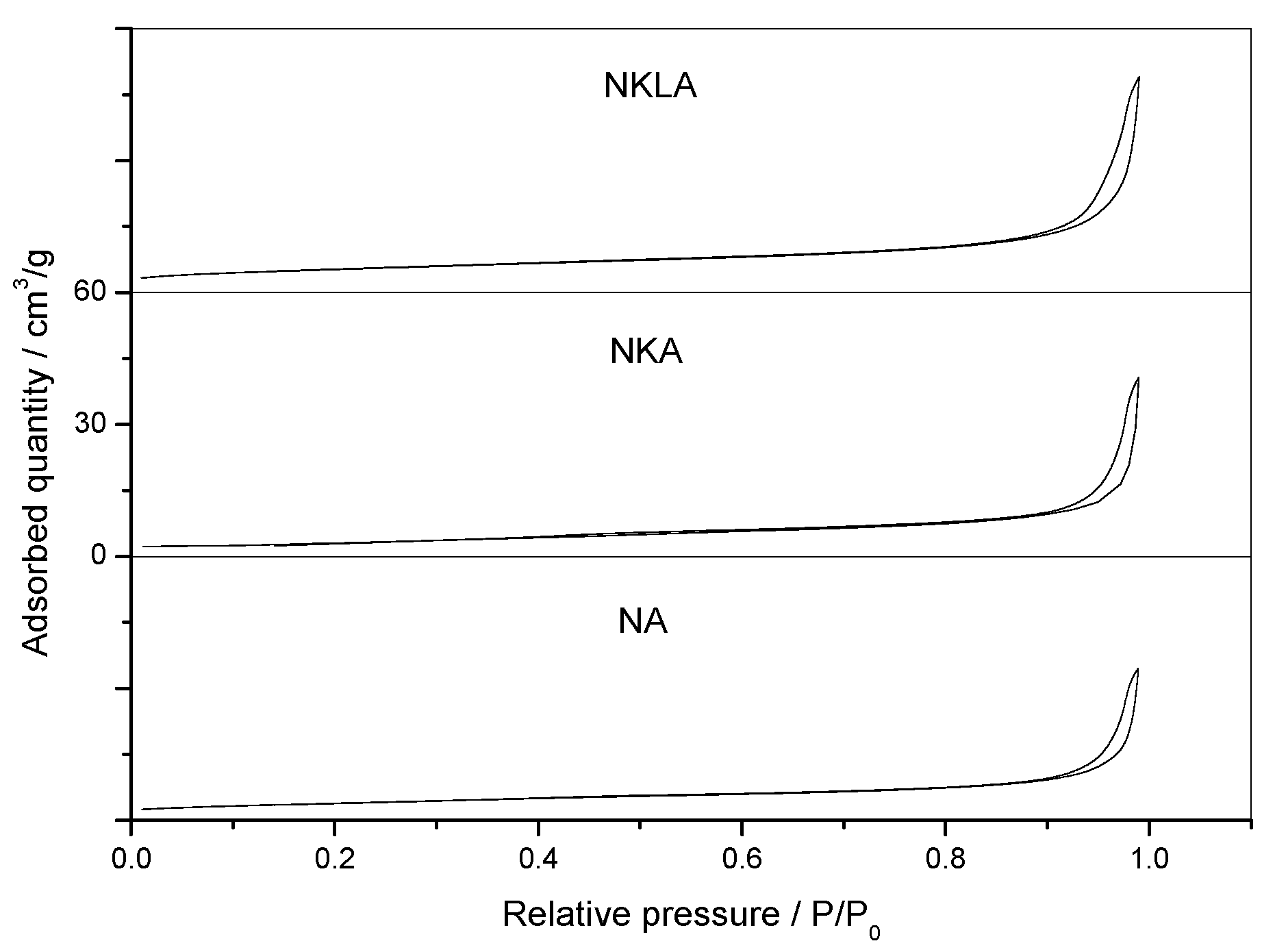
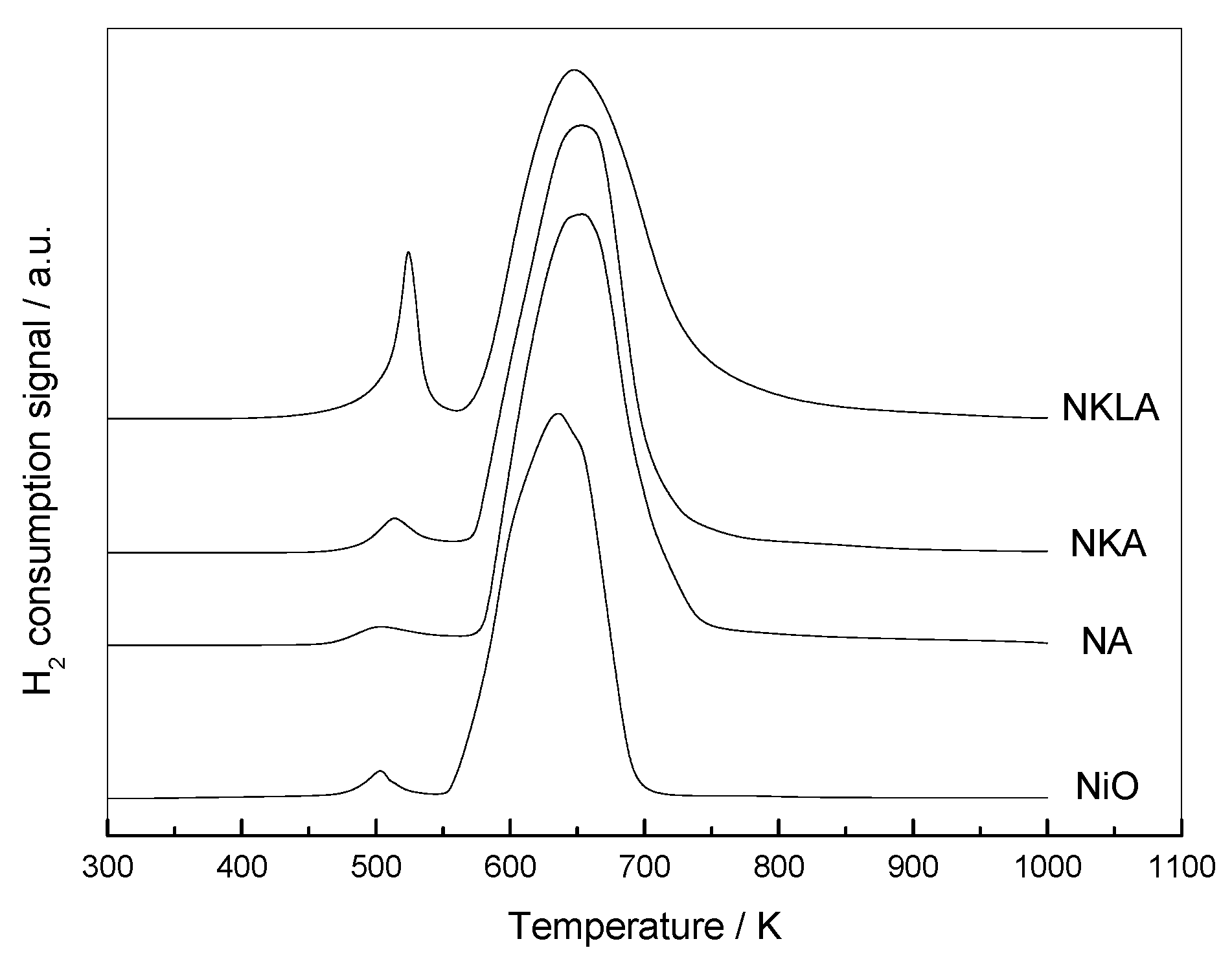
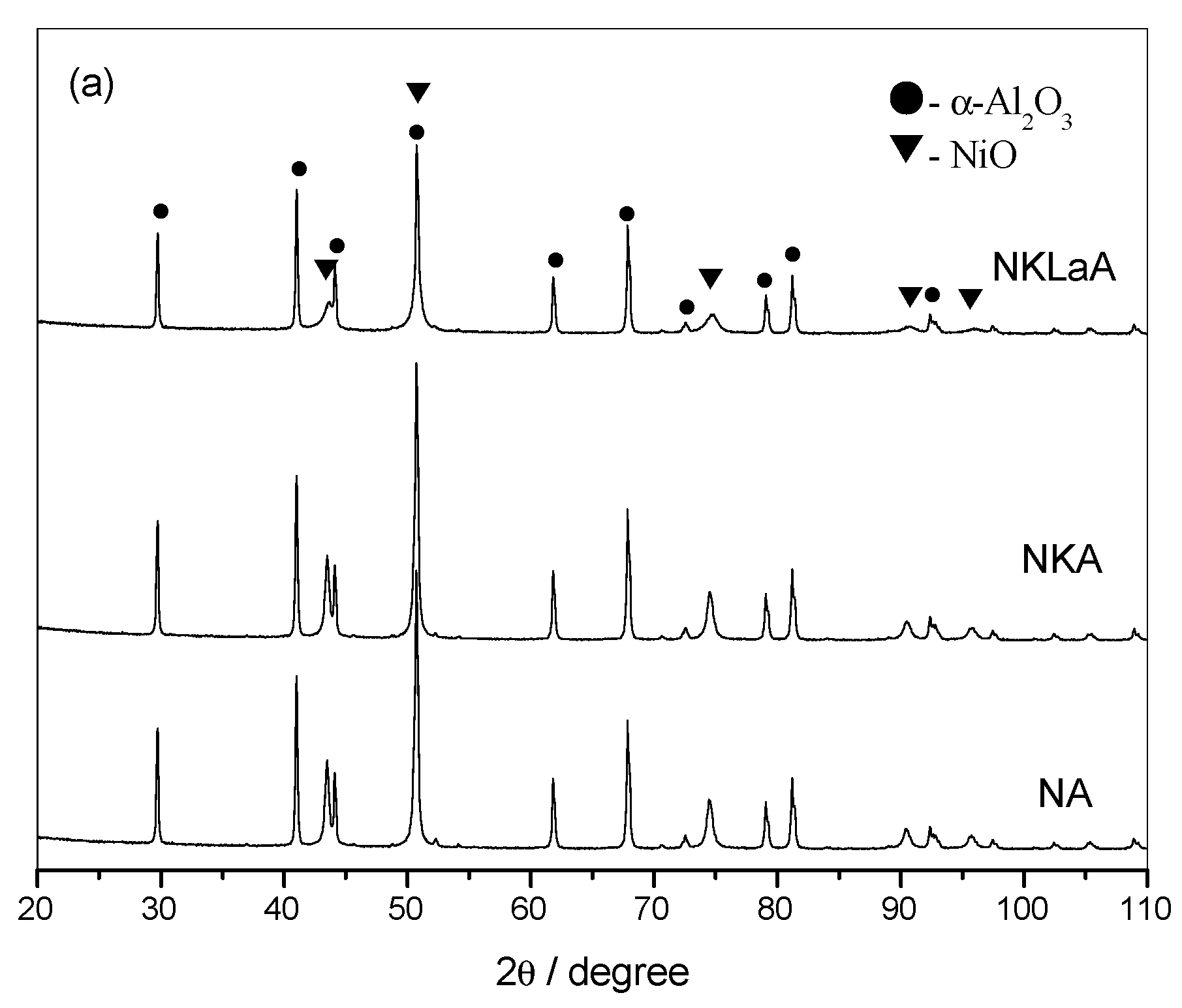

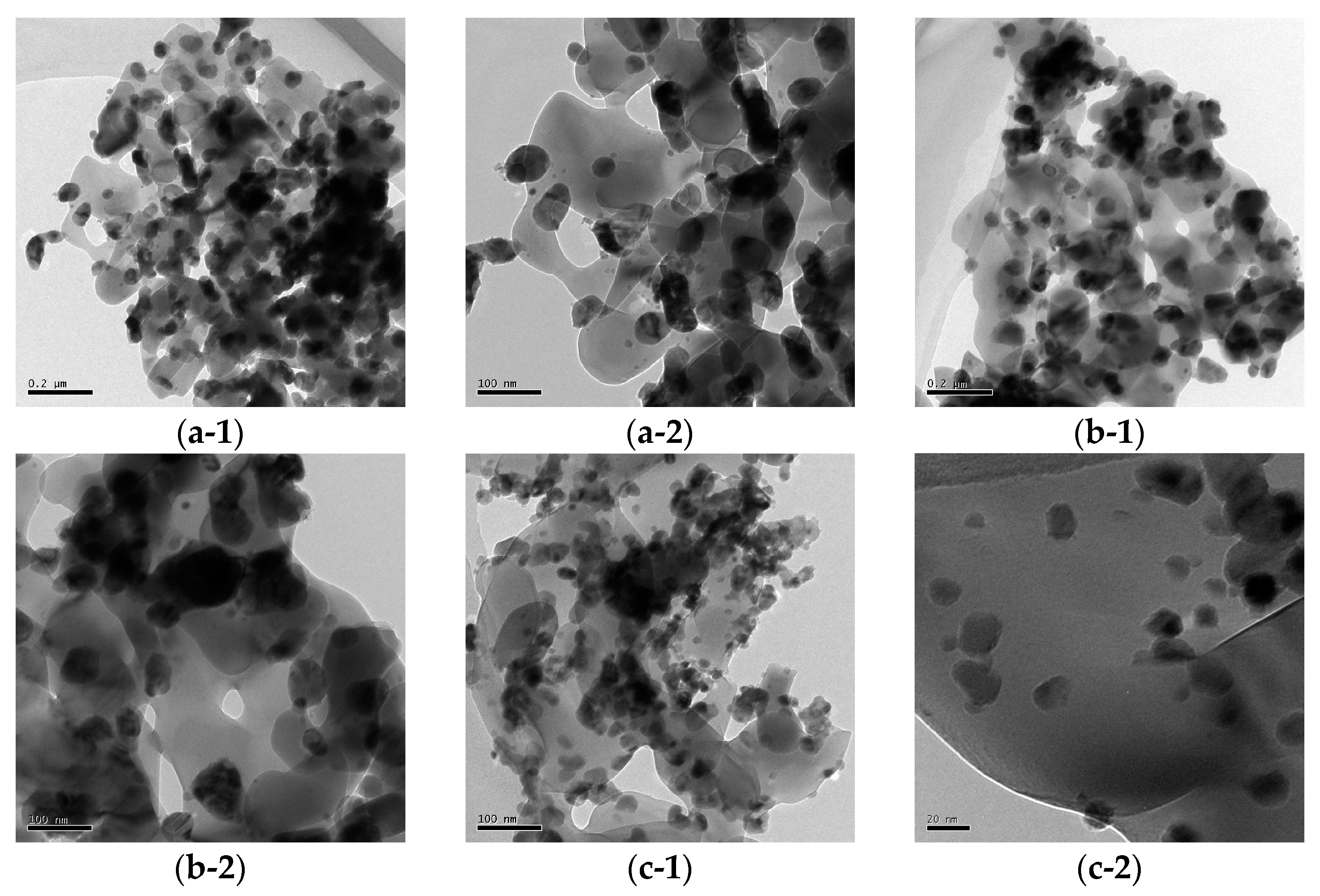

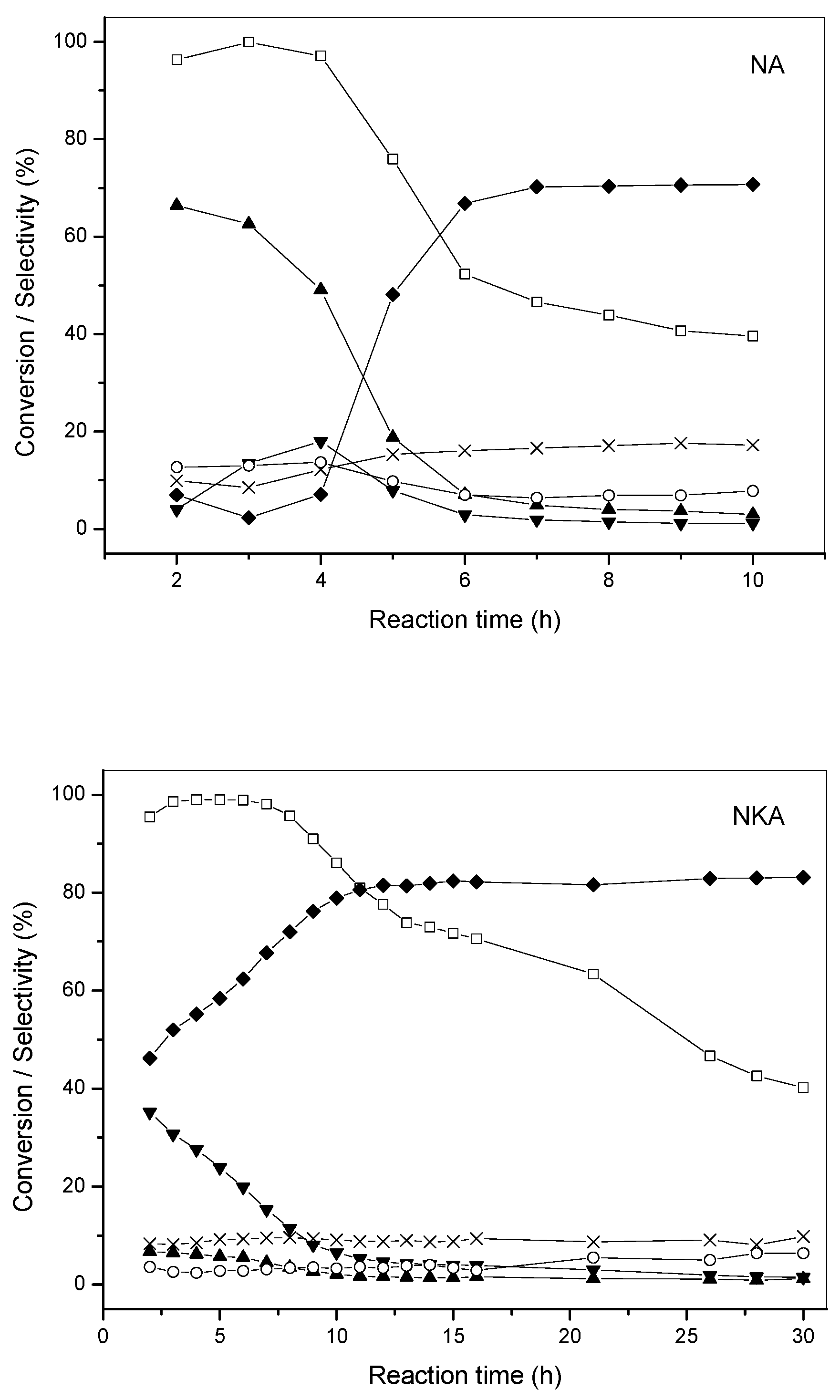

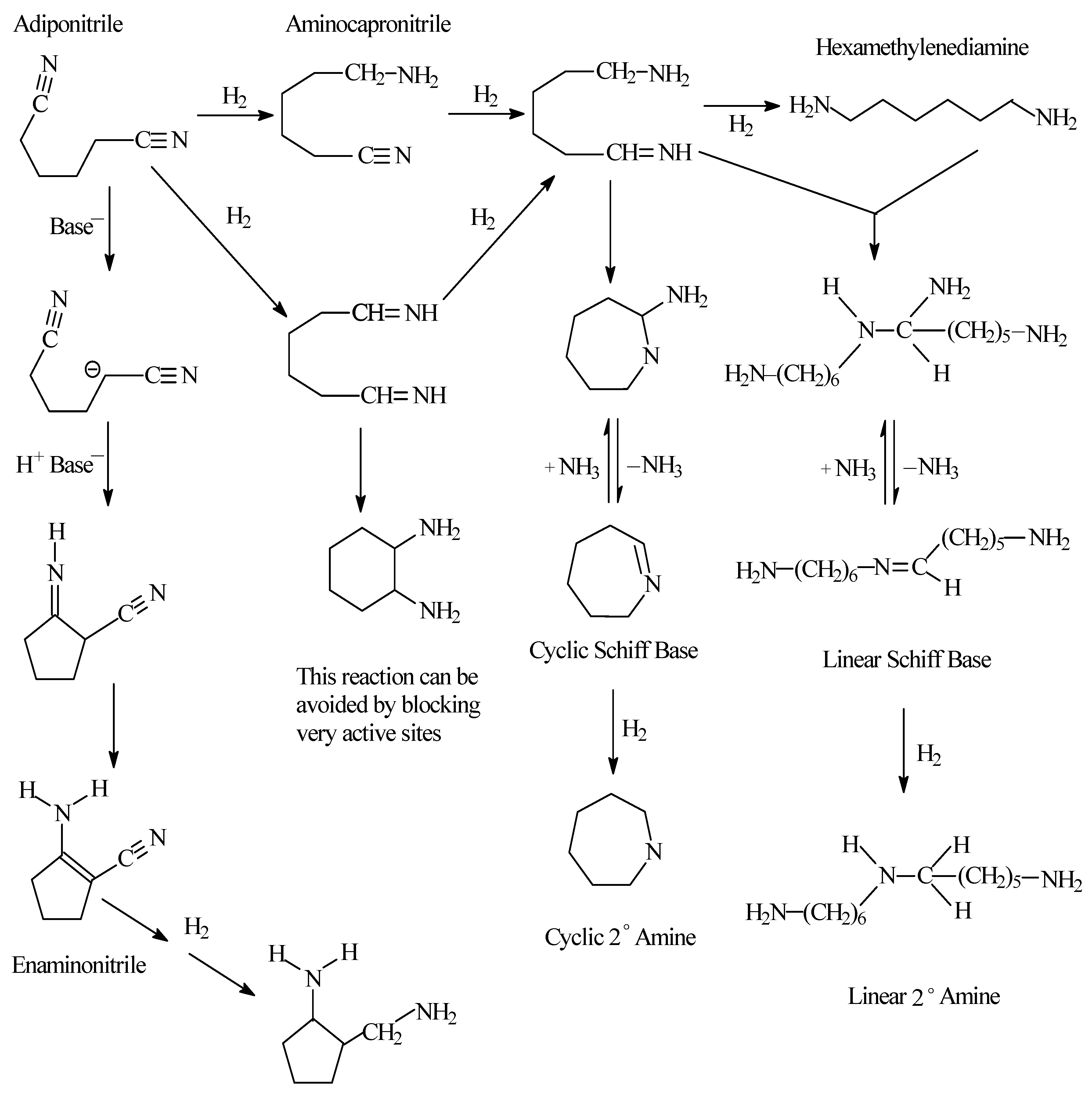
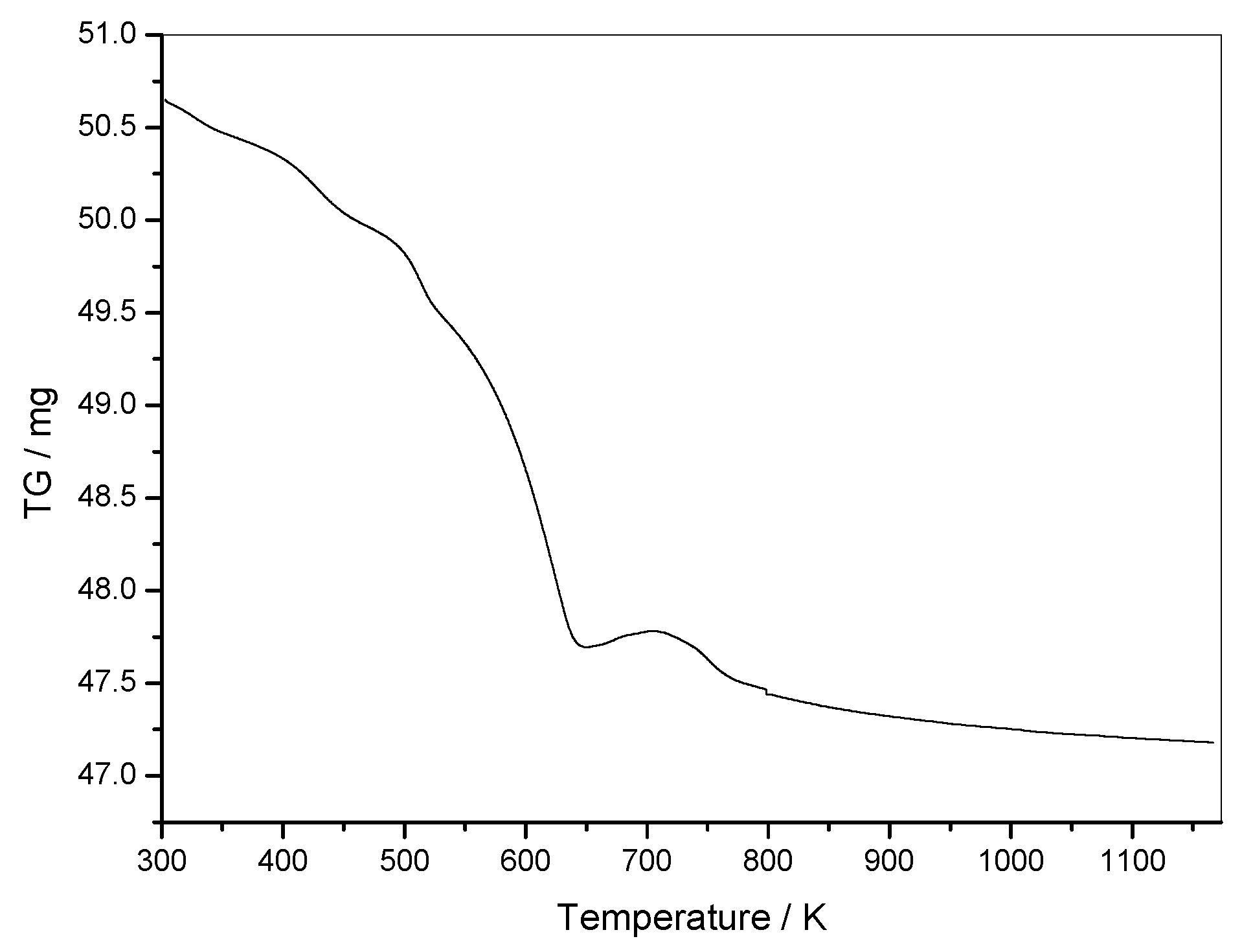
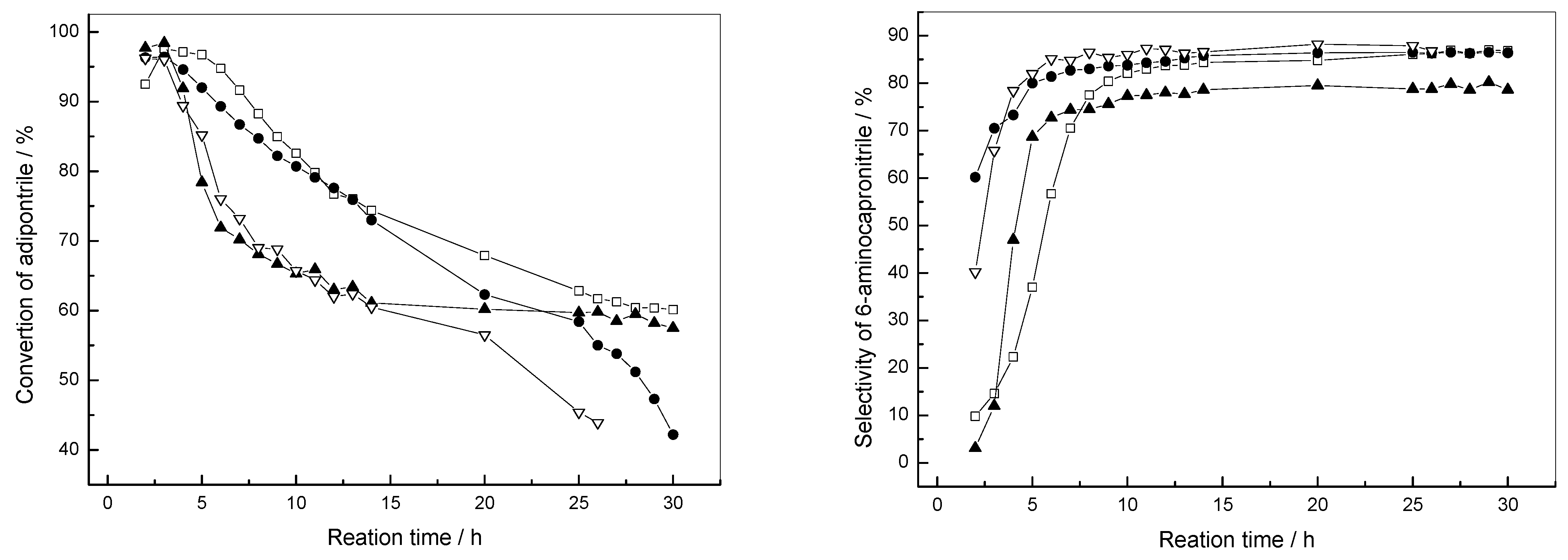
| Catalyst | SBET /m2/g | Vp /cm3/g | Dp /nm | Chemisorbed H2 /μmol/g.cat |
|---|---|---|---|---|
| NA | 14.0 | 0.054 | 15.6 | 9.4 |
| NKA | 10.9 | 0.063 | 17.3 | 12.9 |
| NKLA | 18.9 | 0.077 | 17.0 | 53.4 |
| The Fresh Catalyst | The Deactivated Catalyst | ||||
|---|---|---|---|---|---|
| Element | Weight/% | Atom Ratio/% | Element | Weight Ratio/% | Atom Content/% |
| C K | / | / | C K | 11.15 | 19.44 |
| N K | / | / | N K | 1.00 | 1.50 |
| O K | 39.49 | 58.82 | O K | 37.28 | 48.82 |
| Al K | 35.88 | 31.68 | Al K | 30.01 | 23.30 |
| K K | 0.02 | 0.01 | K K | 0.18 | 0.10 |
| Ni K | 22.47 | 9.12 | Ni K | 18.32 | 6.54 |
| La L | 2.13 | 0.37 | La L | 2.06 | 0.31 |
| Total | 100.00 | Total | 100.00 | ||
Disclaimer/Publisher’s Note: The statements, opinions and data contained in all publications are solely those of the individual author(s) and contributor(s) and not of MDPI and/or the editor(s). MDPI and/or the editor(s) disclaim responsibility for any injury to people or property resulting from any ideas, methods, instructions or products referred to in the content. |
© 2023 by the authors. Licensee MDPI, Basel, Switzerland. This article is an open access article distributed under the terms and conditions of the Creative Commons Attribution (CC BY) license (https://creativecommons.org/licenses/by/4.0/).
Share and Cite
Zhao, L.; Wang, C.; Chen, J.; Nie, Z.; Zhang, J.; Lu, X. Selective Hydrogenation of Adiponitrile to 6-Aminocapronitrile over Ni/α-Al2O3 Catalysts Doped with K2O and La2O3. Catalysts 2023, 13, 934. https://doi.org/10.3390/catal13060934
Zhao L, Wang C, Chen J, Nie Z, Zhang J, Lu X. Selective Hydrogenation of Adiponitrile to 6-Aminocapronitrile over Ni/α-Al2O3 Catalysts Doped with K2O and La2O3. Catalysts. 2023; 13(6):934. https://doi.org/10.3390/catal13060934
Chicago/Turabian StyleZhao, Lei, Caiyun Wang, Jixiang Chen, Ziyang Nie, Jiyan Zhang, and Xuebin Lu. 2023. "Selective Hydrogenation of Adiponitrile to 6-Aminocapronitrile over Ni/α-Al2O3 Catalysts Doped with K2O and La2O3" Catalysts 13, no. 6: 934. https://doi.org/10.3390/catal13060934
APA StyleZhao, L., Wang, C., Chen, J., Nie, Z., Zhang, J., & Lu, X. (2023). Selective Hydrogenation of Adiponitrile to 6-Aminocapronitrile over Ni/α-Al2O3 Catalysts Doped with K2O and La2O3. Catalysts, 13(6), 934. https://doi.org/10.3390/catal13060934






